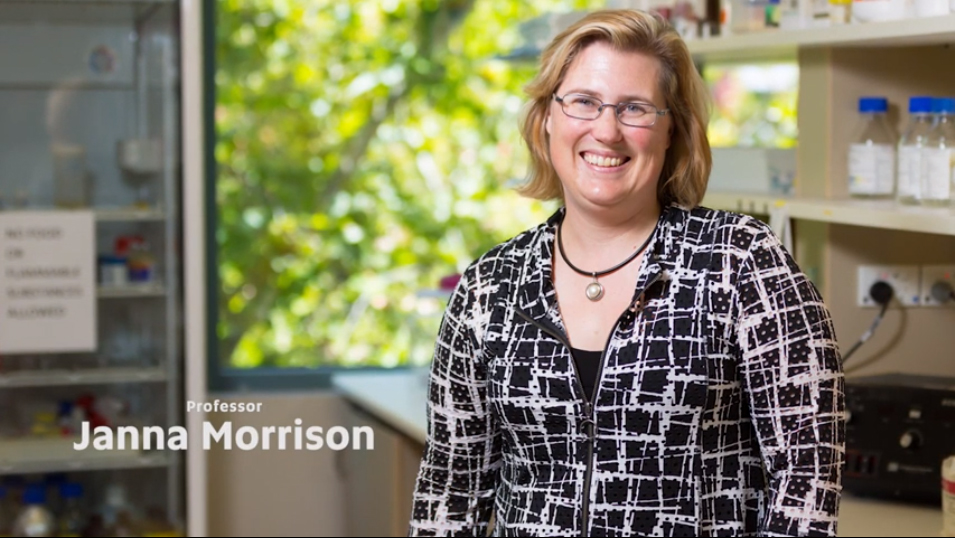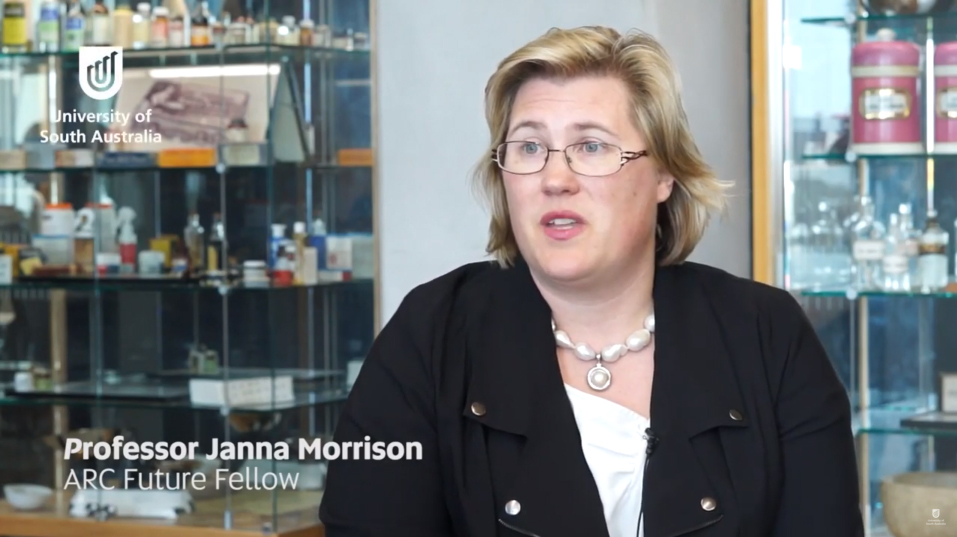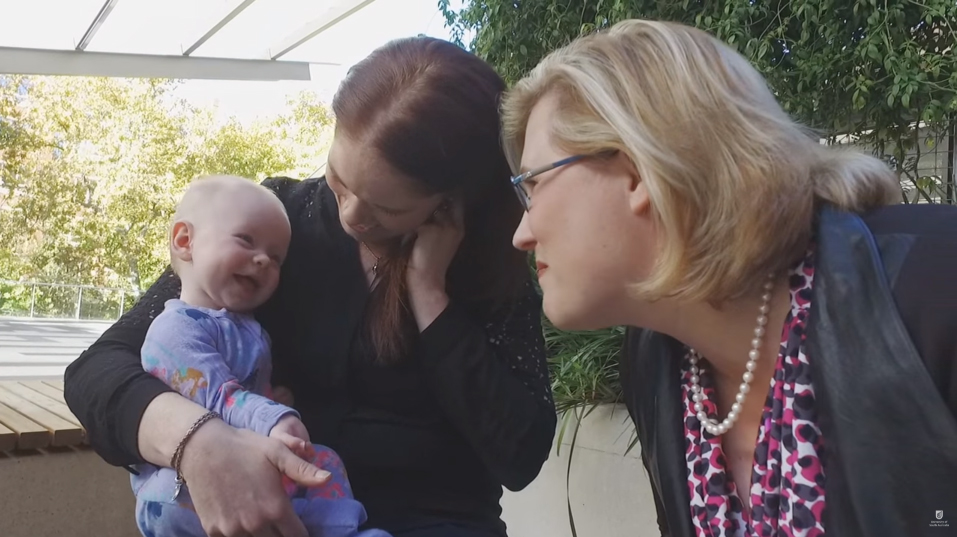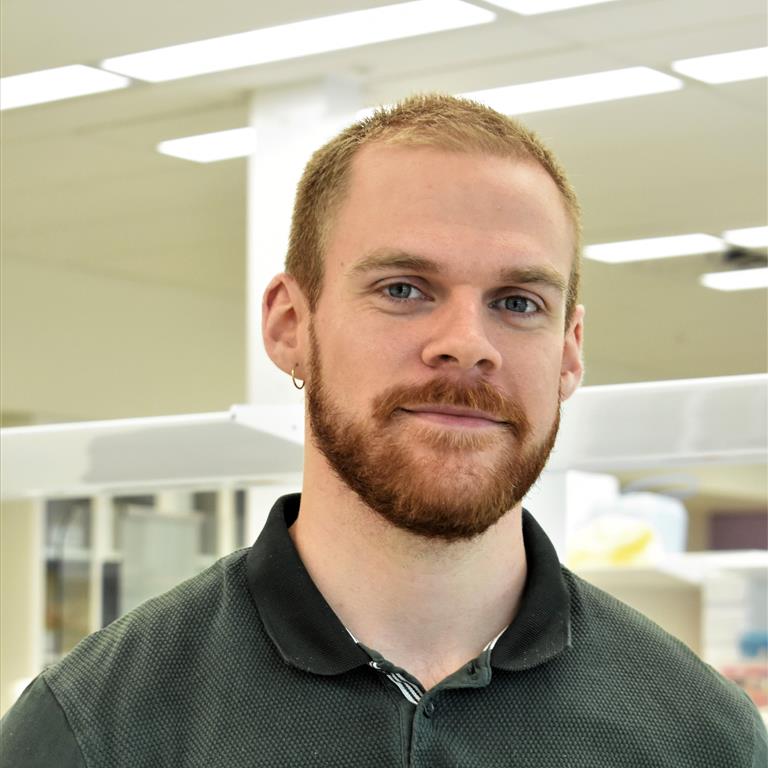An international leader in research in pregnancy and fetal development, the University of South Australia’s Early Origins of Adult Health Research Group (EOAHRG) is engaged in important projects determining how events before birth have an impact on health later in life.
The group uses a range of models and analytical techniques to investigate how the physiological environment from before conception and during pregnancy can contribute to a range of conditions in adulthood such as cardiovascular disease, asthma, obesity and diabetes. Functional studies of blood pressure regulation and glucose tolerance are linked to the molecular signalling pathways that regulated these events. We are one of few groups internationally that uses MRI to measure fetal hemodynamics, fetal oxygenation and fetal cardiac function.
Established in 2005, the EOAHRG brings together a research team with an international track record in systems physiology with a focus on fetal, cardiovascular and respiratory physiology, drug metabolism, epigenetics, metabolism and endocrinology. The group's research is focused in three broad areas: the early origins of cardiovascular disease, and development of a healthy heart and cardiorespiratory system and the impact of pregnancy complications on drug exposure. We have a strong track record of collaboration with other international leaders in these areas, including researchers from Cambridge (UK), SickKids (Canada), Kings College London (UK) and Otago University (NZ). This work has been underpinned by funding from the Heart Foundation of Australia, National Health and Medical Research Council, Australian Research Council, Cerebral Palsy Australia and the Canadian Institutes of Health Research.



Our people
Our Researchers
-
Additional researchers
Eric Schrauben

Research Fellow, Translational Medicine, Hospital for Sick Children, Toronto, Canada
My background is MRI acquisition, image reconstruction, and data analysis for blood flow assessment. At EOAHRG, we aim to comprehensively assess blood flow patterns inside of a living sheep fetus through the use of a technique called 4D flow MRI. This allows for the visualization and measurement of intricate 3D blood flow in this unique physiological environment, and we believe it will help us better understand normal and abnormal changes during development.
Recent publications
- Schrauben, E.M., Saini, B.S., Darby, J.R., Soo, J.Y., Lock, M.C., Stirrat, E., Stortz, G., Sled, J.G., Morrison, J.L., Seed, M. and Macgowan, C.K., 2019. Fetal hemodynamics and cardiac streaming assessed by 4D flow cardiovascular magnetic resonance in fetal sheep. Journal of Cardiovascular Magnetic Resonance, 21(1), p.8. https://doi.org/10.1186/s12968-018-0512-5.
Interesting papers I’ve read lately
- van Amerom JFP, Lloyd DFA, Deprez M, Price AN, Malik SJ, Pushparajah K, van Poppel MPM, Rutherford MA, Razavi R, Hajnal JV. Fetal whole-heart 4D imaging using motion-corrected multi-planar real-time MRI. Magn Reson Med 2019;82(3):1055-1072.
- Macdonald JA, Corrado PA, Nguyen SM, Johnson KM, Francois CJ, Magness RR, Shah DM, Golos TG, Wieben O. Uteroplacental and Fetal 4D Flow MRI in the Pregnant Rhesus Macaque. J Magn Reson Imaging 2019;49(2):534-545.
- Haris K, Hedstrom E, Kording F, Bidhult S, Steding-Ehrenborg K, Ruprecht C, Heiberg E, Arheden H, Aletras AH. Free-breathing fetal cardiac MRI with doppler ultrasound gating, compressed sensing, and motion compensation. J Magn Reson Imaging 2019.
- Kolbitsch C, Bastkowski R, Schaffter T, Prieto Vasquez C, Weiss K, Maintz D, Giese D. Respiratory motion corrected 4D flow using golden radial phase encoding. Magn Reson Med 2019.
- Bastkowski R, Weiss K, Maintz D, Giese D. Self-gated golden-angle spiral 4D flow MRI. Magn Reson Med 2018;80(3):904-913.
Jia Yin Soo

Clinical Pharmacist, The Royal Women’s Hospital
Hepatic metabolism, which results in biotransformation of a drug, is a major determinant of exposure to a drug. Babies born preterm or with a low birth weight due to different maternal factors including drug use are at higher risk for poor neonatal outcomes. These babies are also more likely to require admission to Neonatal Intensive Care and hence are may require medication during the early stages of life. The focus of my project was to understand the impact of intrauterine growth restriction, preterm birth and maternal drug use on the exposed baby’s ability to respond to and clear medication from its system.
Recent publications
- Lock, M.C., Darby, J.R., Soo, J.Y., Brooks, D.A., Perumal, S.R., Selvanayagam, J.B., Seed, M., Macgowan, C.K., Porrello, E.R., Tellam, R.L. and Morrison, J.L., 2019. Differential response to injury in fetal and adolescent sheep hearts in the immediate post myocardial infarction period. Frontiers in physiology, 10, p.208.
https://doi.org/10.3389/fphys.2019.00208 - Schrauben, E.M., Saini, B.S., Darby, J.R., Soo, J.Y., Lock, M.C., Stirrat, E., Stortz, G., Sled, J.G., Morrison, J.L., Seed, M. and Macgowan, C.K., 2019. Fetal hemodynamics and cardiac streaming assessed by 4D flow cardiovascular magnetic resonance in fetal sheep. Journal of Cardiovascular Magnetic Resonance, 21(1), p.8.
https://doi.org/10.1186/s12968-018-0512-5. - Soo J. Y, Wiese, M. D., Berry, M. J., McMillen I. C., Morrison J. L., 2018. Intrauterine growth restriction may reduce hepatic drug metabolism in the early neonatal period. Pharmacological Research
https://doi.org/10.1016/j.phrs.2018.06.003 - Soo J. Y, Wiese, M. D., Berry, M. J., Morrison J. L., 2018. Does poor fetal growth influence the extent of fetal exposure to maternal medications. Pharmacological Research https://doi.org/10.1016/j.phrs.2018.02.00
- Sorvina, A., Bader, C.A., Darby, J.R., Lock, M.C., Soo, J.Y., Johnson, I.R., Caporale, C., Voelcker, N.H., Stagni, S., Massi, M. and Morrison, J.L., 2018. Mitochondrial imaging in live or fixed tissues using a luminescent iridium complex. Scientific reports, 8(1), p.8191.
https://doi.org/10.1038/s41598-018-24672-w - Soo J. Y, Orgeig S., McGillick E. V., Zhang S., McMillen I. C., Morrison J. L., 2017. Normalisation of Surfactant Protein-A and-B Expression in the Lungs of Low Birth Weight Lambs by 21 Days Old."PLoS one 12, no. 9.
https://doi.org/10.1371/journal.pone.0181185 - Duan, A.Q., Darby, J.R., Soo, J.Y., Lock, M.C., Zhu, M.Y., Flynn, L.V., Perumal, S.R., Macgowan, C.K., Selvanayagam, J.B., Morrison, J.L. and Seed, M., 2017. Feasibility of phase-contrast cine magnetic resonance imaging for measuring blood flow in the sheep fetus. American Journal of Physiology-Regulatory, Integrative and Comparative Physiology.
https://doi.org/10.1152/ajpregu.00273.2017 - Duan, A.Q., Lock, M.C., Perumal, S.R., Darby, J.R., Soo, J.Y., Selvanayagam, J.B., Macgowan, C.K., Seed, M. and Morrison, J.L., 2017. Feasibility of detecting myocardial infarction in the sheep fetus using late gadolinium enhancement CMR imaging. Journal of Cardiovascular Magnetic Resonance, 19(1), p.69. https://doi.org/10.1186/s12968-017-0383-1
Interesting papers I’ve read lately
- Alcazar MAA, Östreicher I, Appel S, Rother E, Vohlen C, Plank C & Dötsch J. (2011). Developmental regulation of inflammatory cytokine-mediated Stat3 signalling: the missing link between intrauterine growth restriction and pulmonary dysfunction? Journal of Molecular Medicine, 1-13.
https://doi.org/10.1007/s00109-012-0860-9 - Wang Y, Santos J, Sakurai R, Shin E, Cerny L, Torday JS & Rehan VK. (2009). Peroxisome Proliferator-Activated Receptor Gamma Agonists Enhance Lung Maturation in a Neonatal Rat Model. Pediatric research 65, 150-155. https://doi.org/10.1203/PDR.0b013e3181938c40
- Moretti ME, Rezvani M & Koren G. (2008). Safety of glyburide for gestational diabetes: a meta-analysis of pregnancy outcomes. Annals of Pharmacotherapy 42, 483-490. https://doi.org/10.1345/aph.1K577
- Rowan JA, Hague WM, Gao W, Battin MR & Moore MP. (2008). Metformin versus insulin for the treatment of gestational diabetes. New England Journal of Medicine 358, 2003-2015. https://doi.org/10.1056/NEJMoa0707193
- Moretti ME, Rezvani M & Koren G. (2008). Safety of glyburide for gestational diabetes: a meta-analysis of pregnancy outcomes. Annals of Pharmacotherapy 42, 483-490. https://doi.org/10.1345/aph.1K577
Dr Mitchell Lock

Research Associate, The University of Manchester / University of Cambridge
The goal of my research is to understand how genes and miRNAs regulate the proliferation of heart cells during pregnancy. By understanding how the heart grows and repairs after damage in-utero; we can identify new possible therapeutic targets to heal an adult heart (such as after a heart attack). More recently I have been investigating the effects of anti-oxidants and antenatal glucocorticoid administration on fetal lung development in hypoxic pregnancies. My current focus is on the dysregulation of calcium signalling within the heart of adult offspring from hypoxic pregnancies, and how this may be prevented with anti-oxidant treatment in-utero.
Recent publications
- Clifton, V.L., McDonald, M., Morrison, J.L., Holman, S.L., Lock, M.C., Saif, Z., Meakin, A., Woolridge, A.L., Gatford, K.L., Wallace, M.J., Muhlhausler, B.S., Bischof, R.J., Moss, T.J.M., 2019. Placental glucocorticoid receptor isoforms in a sheep model of maternal allergic asthma. Placenta. https://doi.org/10.1016/j.placenta.2019.06.380
- Lock, M.C., Darby, J.R., Soo, J.Y., Brooks, D.A., Perumal, S.R., Selvanayagam, J.B., Seed, M., Macgowan, C.K., Porrello, E.R., Tellam, R.L. and Morrison, J.L., 2019. Differential response to injury in fetal and adolescent sheep hearts in the immediate post myocardial infarction period. Frontiers in physiology, 10, p.208. https://doi.org/10.3389/fphys.2019.00208
- Schrauben, E.M., Saini, B.S., Darby, J.R., Soo, J.Y., Lock, M.C., Stirrat, E., Stortz, G., Sled, J.G., Morrison, J.L., Seed, M. and Macgowan, C.K., 2019. Fetal hemodynamics and cardiac streaming assessed by 4D flow cardiovascular magnetic resonance in fetal sheep. Journal of Cardiovascular Magnetic Resonance, 21(1), p.8. https://doi.org/10.1186/s12968-018-0512-5.
- Morrison, J.L., Berry, M.J., Botting, K.J., Darby, J.R., Frasch, M.G., Gatford, K.L., Giussani, D.A., Gray, C.L., Harding, R., Herrera, E.A. and Kemp, M.W., Lock, M.C., McMillen, I.C., Moss, T.J., Musk, G.C., Oliver, M.H., Regnault, T.R.H., Roberts, C.T., Soo J., Tellam R.L., 2018. Improving pregnancy outcomes in humans through studies in sheep. American Journal of Physiology-Regulatory, Integrative and Comparative Physiology, 315(6), pp.R1123-R1153. https://doi.org/10.1152/ajpregu.00391.2017
- Lock, M.C., Tellam R.L., Botting, K.J., Wang, K.C.W., Selvanayagam, J.B., Brooks, D.A., Seed, M., Morrison, J.L., 2018. The role of miRNA regulation in fetal cardiomyocytes, cardiac maturation and the risk of heart disease in adults. Journal of Physiology. https://doi.org/10.1113/JP276072
- Sorvina, A., Bader, C.A., Darby, J.R., Lock, M.C., Soo, J.Y., Johnson, I.R., Caporale, C., Voelcker, N.H., Stagni, S., Massi, M. and Morrison, J.L., 2018. Mitochondrial imaging in live or fixed tissues using a luminescent iridium complex. Scientific reports, 8(1), p.8191. https://doi.org/10.1038/s41598-018-24672-w
- Morrison, J.L., Sorvina, A., Darby, J.R., Bader, C.A., Lock, M.C., Seed, M., Kuchel, T., Plush S.E., Brooks D.A., 2017. Label-free imaging of redox status and collagen deposition showing metabolic differences in the heart. Journal of Biophotonics. https://doi:10.1002/jbio.201700242
- Duan, A.Q., Darby, J.R., Soo, J.Y., Lock, M.C., Zhu, M.Y., Flynn, L.V., Perumal, S.R., Macgowan, C.K., Selvanayagam, J.B., Morrison, J.L. and Seed, M., 2017. Feasibility of phase-contrast cine magnetic resonance imaging for measuring blood flow in the sheep fetus. American Journal of Physiology-Regulatory, Integrative and Comparative Physiology. https://doi.org/10.1152/ajpregu.00273.2017
- Duan, A.Q., Lock, M.C., Perumal, S.R., Darby, J.R., Soo, J.Y., Selvanayagam, J.B., Macgowan, C.K., Seed, M. and Morrison, J.L., 2017. Feasibility of detecting myocardial infarction in the sheep fetus using late gadolinium enhancement CMR imaging. Journal of Cardiovascular Magnetic Resonance, 19(1), p.69. https://doi.org/10.1186/s12968-017-0383-1
- Sorvina, A., Bader, C.A., Lock, M.C., Brooks, D.A., Morrison, J.L., Plush, S.E., 2017. Label-free imaging of healthy and infarcted fetal sheep hearts by two-photon microscopy. Journal of Biophotonics. https://doi.org/10.1002/jbio.201600296
- Lock, M.C., McGillick E.V., Orgeig S., McMillen I.C., Mühlhäusler B.S., Zhang S., Morrison J.L., 2017. Differential effects of late gestation maternal overnutrition on the regulation of surfactant maturation in fetal and postnatal life. Journal of Physiology. 2017 https://doi.org/10.1113/JP274528
- Lock, M.C., Botting, K.J., Tellam R.L., Brooks, D.A., Morrison J.L., 2017. Adverse Intrauterine Environment and Cardiac miRNA Expression. International journal of molecular sciences. https://doi.org/10.3390/ijms18122628
- McGillick E.V.*, Lock, M.C.*, Orgeig S., Morrison J.L., 2016. Maternal obesity mediated predisposition to respiratory complications at birth and in later life: understanding the implications of the obesogenic intrauterine environment. Paediatric Respiratory Reviews. *denotes equal contribution. https://dx.doi.org/10.1016/j.prrv.2016.10.003
- Lock, M.C., McGillick E.V., Orgeig S., Zhang S., McMillen I.C., Morrison J.L., 2015. Mature surfactant protein-B expression by immunohistochemistry as a marker for surfactant system development in the fetal sheep lung. Journal of Histochemistry and Cytochemistry. 63(11), p.866-878. http://doi.org/10.1369/0022155415600201
- Lock M.C. McGillick E.V., Orgeig S., McMillen I.C., Morrison J.L., 2013. Regulation of fetal lung development in response to maternal overnutrition. Clinical and Experimental Pharmacology and Physiology 40 (11), p.803-816. https://doi.org/10.1111/1440-1681.12166
Interesting papers I’ve read lately
- Sato, A., A. Schehr, and M. Ikegami (2011) Leptin does not influence surfactant synthesis in fetal sheep and mice lungs. American Journal of Physiology - Lung Cellular and Molecular Physiology 300:498-505.
https://doi.org/10.1152/ajplung.00418.2010 - Flecknoe SJ, Wallace MJ, Cock ML, Harding R, Hooper SB (2003) Changes in alveolar epithelial cell proportions during fetal and postnatal development in sheep. American journal of physiology Lung cellular and molecular physiology. 285:L664-670. https://doi.org/10.1152/ajplung.00306.2002
- Herdrich BJ, Danzer E, Davey MG, Allukian M, Englefield V, Gorman JH 3rd, Gorman RC, Liechty KW. (2010). Regenerative healing following foetal myocardial infarction. Eur J Cardiothorac Surg. 38(6):691-698. https://doi.org/10.1016/j.ejcts.2010.03.049
- Allukian M 3rd1, Xu J, Morris M, Caskey R, Dorsett-Martin W, Plappert T, Griswold M, Gorman JH 3rd, Gorman RC, Liechty KW (2013). Mammalian cardiac regeneration after fetal myocardial infarction requires cardiac progenitor cell recruitment. Ann Thorac Surg. 96(1):163-70. https://doi.org/ 10.1016/j.athoracsur.2013.04.005
- Zgheib C, Allukian MW, Xu J, Morris MW, Jr., Caskey RC, Herdrich BJ, Hu J, Gorman JH, 3rd, Gorman RC, Liechty KW (2014). Mammalian fetal cardiac regeneration after myocardial infarction is associated with differential gene expression compared with the adult. Ann Thorac Surg. 97(5):1643-1650. https://doi.org/10.1016/j.athoracsur.2014.01.013.
Orcid | Google Scholar | ResearchGate
Dr Tamara Varcoe

Postdoctoral research fellow, Early Origins of Adult Health Research Group & Molecular and Evolutionary Physiology of the Lung Laboratory
Dr Tamara Varcoe completed her PhD 2008 at The University of Adelaide, under the supervision of Professor David Kennaway, where she investigated the role of serotonin receptors in the mammalian circadian timing system. Her research now focuses on how the circadian system regulates diverse physiological processes including reproduction, metabolism and the programming of adult health and disease. She was the first to demonstrate that exposure to a simulated shift work exposure impairs metabolic health of adult rat offspring. Using knock out and mutant mouse models, she then dissected the mechanistic pathways by which maternal circadian rhythms affect fetal growth and long-term health. She is now pursuing this line of research using sheep as an animal model, with the aim of identifying the stage of gestation most susceptible to maternal shift work exposure and the mechanisms responsible.
Recent publications
- Gatford, K.L., Kennaway, D.J., Liu, H., Kleemann, D.O., Kuchel, T.R. and Varcoe, T.J., 2019. Simulated shift work disrupts maternal circadian rhythms and metabolism, and increases gestation length in sheep. The Journal of physiology, 597(7), pp.1889-1904. https://doi.org/10.1113/JP277702
- Varcoe, T.J., 2018. Timing is everything: maternal circadian rhythms and the developmental origins of health and disease. The Journal of physiology, 596(23), pp.5493-5494. https://doi.org/10.1113/JP276992
- Fernandez, R.C., Moore, V.M., Van Ryswyk, E.M., Varcoe, T.J., Rodgers, R.J., March, W.A., Moran, L.J., Avery, J.C., McEvoy, R.D. and Davies, M.J., 2018. Sleep disturbances in women with polycystic ovary syndrome: prevalence, pathophysiology, impact and management strategies. Nature and science of sleep, 10, p.45. https://doi.org/10.1080/09513590.2016.1196177
- Varcoe, T.J., Gatford, K.L. and Kennaway, D.J., 2017. Maternal circadian rhythms and the programming of adult health and disease. American Journal of Physiology-Regulatory, Integrative and Comparative Physiology, 314(2), pp.R231-R241. https://doi.org/10.1152/ajpregu.00248.2017
- Varcoe, T.J., Voultsios, A., Gatford, K.L. and Kennaway, D.J., 2016. The impact of prenatal circadian rhythm disruption on pregnancy outcomes and long-term metabolic health of mice progeny. Chronobiology international, 33(9), pp.1171-1181. https://doi.org/10.1080/07420528.2016.1207661
- Fernandez, R.C., Marino, J.L., Varcoe, T.J., Davis, S., Moran, L.J., Rumbold, A.R., Brown, H.M., Whitrow, M.J., Davies, M.J. and Moore, V.M., 2016, March. Fixed or rotating night shift work undertaken by women: implications for fertility and miscarriage. In Seminars in reproductive medicine (Vol. 34, No. 02, pp. 074-082). Thieme Medical Publishers. https://doi.org/10.1055/s-0036-1571354
Interesting papers I’ve read lately
- Facco, F.L. et al. (2017) Objectively measured short sleep duration and later sleep midpoint in pregnancy are associated with a higher risk of gestational diabetes. Am. J. Obstet. Gynecol., 217, 447.e1–447.e13.
doi: 10.1016/j.ajog.2017.05.066. - Cai C, Vandermeer B, Khurana R, Nerenberg K, Featherstone R, Sebastianski M & Davenport MH (2019) The impact of occupational shift work and working hours during pregnancy on health outcomes: a systematic review and meta-analysis. Am. J. Obstet. Gynecol. Jul 2. pii: S0002-9378(19)30884-1. doi: 10.1016/j.ajog.2019.06.051.
- Mendez, N. et al., 2016, Gestational chronodisruption impairs circadian physiology in rat male offspring, increasing the risk of chronic disease.: Endocrinology, v. 157, no. 12, p. 4654–4668. doi: 10.1210/en.2016-1282
- Landgraf, D., C. Achten, F. Dallmann, and H. Oster, 2015, Embryonic development and maternal regulation of murine circadian clock function.: Chronobiology International, v. 32, no. 3, p. 416–427.
doi: 10.3109/07420528.2014.986576 - Mendez N, Torres-Farfan C1, Salazar E, Bascur P, Bastidas C, Vergara K, Spichiger C, Halabi D, Vio CP, Richter HG. Fetal Programming of Renal Dysfunction and High Blood Pressure by Chronodisruption. Front Endocrinol (Lausanne). 2019 Jun 6;10:362. doi: 10.3389/fendo.2019.00362. eCollection 2019
-
Research Students
The Early Origins of Adult Health Research Group has completed 10 HDRs since 2010 with all of them working in teaching and research positions. Four have won competitive Early Career Fellowships (NHMRC) and 3 have undertaken postdocs at Cambridge. Currently, we have several research students working on projects as part of their studies within the University of South Australia.
If you are interested in undertaking post graduate studies with the Early Origins of Adult Health Research Group, please contact Professor Janna Morrison.
Current Postgraduate students
Catherine Dimasi
 PhD Candidate, Early Origins of Adult Health Research Group
PhD Candidate, Early Origins of Adult Health Research GroupThe aim of my research is to understand how genes and miRNAs can regulate proliferation of cardiomyocytes during pregnancy and in post-natal life. By understanding how the heart grows and repairs after damage in utero; we can identify new possible therapeutic targets to heal an adult heart (such as after a heart attack).
Interesting papers I’ve read lately
- Lock, Mitchell C. Tellam, Ross L. Darby, Jack R. T. Soo, Jia Yin Brooks, Doug A. Seed, Mike Selvanayagam, Joseph B. Morrison, Janna L. Identification of Novel miRNAs Involved in Cardiac Repair Following Infarction in Fetal and Adolescent Sheep Hearts. Frontiers in Physiology 11, 614 (2020)
https://doi.org/10.3389/fphys.2020.00614 - Morrison, J. L., Zhang, S., Tellam, R. L., Brooks, D. A., McMillen, I. C., Porrello, E. R., & Botting, K. J. (2015). Regulation of microRNA during cardiomyocyte maturation in sheep. BMC genomics, 16(1), 541.
https://doi.org/10.1186/s12864-015-1693-z - Velayutham, Nivedhitha., Alfieri, Christina M., Agnew, Emma J., Riggs, Kyle W., Baker, R. Scott., Ponny, Sithara Raju., Zafar, Farhan, Yutzey, Katherine E. Cardiomyocyte cell cycling, maturation, and growth by multinucleation in postnatal swine. J. Mol and Cell Cardiology 146 (2020)
https://doi.org/10.1016/j.yjmcc.2020.07.004 - Chattergoon, N.N., Louey, S., Scanlan, T., Lindgren, I., Giraud, G.D. and Thornburg, K.L. (2019), Thyroid hormone receptor function in maturing ovine cardiomyocytes. J Physiol, 597: 2163-2176.
doi:10.1113/JP276874 - Cardoso, A.C., Lam, N.T., Savla, J.J. et al. Mitochondrial substrate utilization regulates cardiomyocyte cell-cycle progression. Nat Metab 2, 167–178 (2020).
https://doi.org/10.1038/s42255-020-0169-x
Brahmdeep S. Saini
 PhD Candidate, Institute of Medical Science, University of Toronto; Heart Centre, The Hospital for Sick Children
PhD Candidate, Institute of Medical Science, University of Toronto; Heart Centre, The Hospital for Sick ChildrenPlacental oxygen transport and consumption in pregnancies with placental dysfunction
I am interested in the investigation of maternal and fetal placental cardiovascular physiology using MRI. MRI offers unique capability to non-invasively quantify both blood flow and oxygen saturation in the major maternal and fetal placental vessels, allowing calculation of oxygen delivery and consumption to and by the fetus, fetal brain and the placenta. Such novel and comprehensive data helps further our knowledge of the underlying physiology and can potentially help in monitoring the health of the fetus in pregnancies complicated by impaired placental hemodynamics. The populations of interest include normal controls, maternal heart disease and fetal growth restriction.
Interesting papers I’ve read lately- Goolaub, D.S., Roy, C.W., Schrauben, E., Sussman, D., Marini, D., Seed, M. and Macgowan, C.K., 2018. Multidimensional fetal flow imaging with cardiovascular magnetic resonance: a feasibility study. Journal of Cardiovascular Magnetic Resonance, 20(1), p.77. https://doi.org/10.1186/s12968-018-0498-z
- Hwuang, E., Vidorreta, M., Schwartz, N., Moon, B.F., Kochar, K., Tisdall, M.D., Detre, J.A. and Witschey, W.R., 2019. Assessment of uterine artery geometry and hemodynamics in human pregnancy with 4d flow mri and its correlation with doppler ultrasound. Journal of Magnetic Resonance Imaging, 49(1), pp.59-68. https://doi.org/10.1002/jmri.26229
- Macdonald, J.A., Corrado, P.A., Nguyen, S.M., Johnson, K.M., Francois, C.J., Magness, R.R., Shah, D.M., Golos, T.G. and Wieben, O., 2019. Uteroplacental and fetal 4D flow MRI in the pregnant rhesus macaque. Journal of Magnetic Resonance Imaging, 49(2), pp.534-545.
https://doi.org/10.1002/jmri.26206 - Roberts, T.A., van Amerom, J.F., Uus, A., Lloyd, D.F., Price, A.N., Tournier, J.D., Jackson, L.H., Malik, S.J., van Poppel, M.P., Pushparajah, K. and Rutherford, M.A., 2019. Fetal whole-heart 4D flow cine MRI using multiple non-coplanar balanced SSFP stacks. bioRxiv, p.635797. https://doi.org/10.1101/635797
ResearchGate profile | LinkedIn
Grace McBride

Masters by Research Candidate, Early Origins of Adult Health Research Group, University of South Australia
Impact of fetal growth on function of drug metabolising enzymes
My current research study explores the effects of fetal growth restriction on the fetus’ ability to metabolise medications. Intrauterine growth restriction (IUGR) affects 6-10% of babies worldwide and is characterised by altered growth in utero and failure to reach genetic growth potential. This increases the risk of non-communicable diseases in adulthood, many of which require treatment with medications. The goal of my research is to determine how drug metabolism changes in a complicated pregnancy, such as IUGR, compared to a healthy pregnancy, by measuring the activity of drug metabolising enzymes known as Cytochrome P450s.Interesting papers I’ve read lately
- Hines, R.N., Ontogeny of human hepatic cytochromes P450. J Biochem Mol Toxicol, 2007. 21(4): p. 169-75. https://doi.org/10.1002/jbt.20179
- Temming, L.A., A.G. Cahill, and L.E. Riley, Clinical management of medications in pregnancy and lactation. Am J Obstet Gynecol, 2016. 214(6): p. 698-702. https://doi.org/10.1016/j.ajog.2016.01.187
- Fanni, D., et al., Overlapping between CYP3A4 and CYP3A7 expression in the fetal human liver during development. J Matern Fetal Neonatal Med, 2014: p. 1-5. https://doi.org/10.3109/14767058.2014.951625
- Ward, R.M. and M.W. Varner, Principles of pharmacokinetics in the pregnant women and fetus. Clin Perinatol, 2019. 46(2): p. 383-398. https://doi.org/10.1016/j.clp.2019.02.014
- Koren, G. and A. Ornoy, The role of the placenta in drug transport and fetal drug exposure. Expert Rev Clin Pharmacol, 2018. 11(4): p. 373-385. https://doi.org/10.1080/17512433.2018.1425615
Tanroop Aujla
 MSc Candidate, Department of Physiology, University of Toronto; Heart Centre, The Hospital for Sick Children
MSc Candidate, Department of Physiology, University of Toronto; Heart Centre, The Hospital for Sick ChildrenPlacental oxygen transport and consumption in pregnancies with placental dysfunction
My research is interested in quantifying the effects of maternal therapeutic supplements administered during pregnancy on fetal cardiovascular physiology using magnetic resonance imaging (MRI). Specifically, I use cine phase-contrast MRI and T2 blood relaxation time to determine blood flow and oxygen saturation of major fetal vessels respectively. With this information, fetal brain oxygen delivery and consumption can be calculated. This non-invasive approach can serve as an important tool in diagnosing fetal cardiovascular disease and determining the effectiveness of therapeutic interventions in cases of placental insufficiency.
Interesting papers I’ve read lately (original articles only)
- Schrauben, E.M., Saini, B.S., Darby, J.R., Soo, J.Y., Lock, M.C., Stirrat, E., Stortz, G., Sled, J.G., Morrison, J.L., Seed, M. and Macgowan, C.K., 2019. Fetal hemodynamics and cardiac streaming assessed by 4D flow cardiovascular magnetic resonance in fetal sheep. Journal of Cardiovascular Magnetic Resonance, 21(1), p.8. https://doi.org/10.1186/s12968-018-0512-5
- El-Sabbagh, A.M., Gray, B.W., Shaffer, A.W., Bryner, B.S., Church, J.T., McLeod, J.S., Zakem, S., Perkins, E.M., Shellhaas, R.A., Barks, J.D. and Rojas-Peña, A., 2018. Cerebral oxygenation of premature lambs supported by an artificial placenta. Asaio Journal, 64(4), pp.552-556. https://doi.org/10.1097/MAT.0000000000000676
- Sun, L., Macgowan, C.K., Sled, J.G., Yoo, S.J., Manlhiot, C., Porayette, P., Grosse-Wortmann, L., Jaeggi, E., McCrindle, B.W., Kingdom, J. and Hickey, E., 2015. Reduced fetal cerebral oxygen consumption is associated with smaller brain size in fetuses with congenital heart disease. Circulation, 131(15), pp.1313-1323. https://doi.org/10.1161/CIRCULATIONAHA.114.013051
- Lim, J.M., Kingdom, T., Saini, B., Chau, V., Post, M., Blaser, S., Macgowan, C., Miller, S.P. and Seed, M., 2016. Cerebral oxygen delivery is reduced in newborns with congenital heart disease. The Journal of thoracic and cardiovascular surgery, 152(4), pp.1095-1103. https://doi.org/10.1016/j.jtcvs.2016.05.027
- Portnoy, S., Seed, M., Sled, J.G. and Macgowan, C.K., 2017. Non‐invasive evaluation of blood oxygen saturation and hematocrit from T1 and T2 relaxation times: In‐vitro validation in fetal blood. Magnetic resonance in medicine, 78(6), pp.2352-2359. https://doi.org/10.1002/mrm.26599
Steven Cho

MSc Candidate, Department of Physiology, University of Toronto; Heart Centre, The Hospital for Sick Children
Impact of late gestation undernutrition on maternal and fetal cardiac function
I am interested in the investigation of fetal cardiovascular physiology using magnetic resonance imaging (MRI). My current research is focused on assessing the feasibility of utilising cardiac MRI imaging to measure cardiac function in the fetal sheep. This research explores the potential of MRI as an important complement to fetal echocardiography in the prenatal study of the fetal heart.
Interesting papers I’ve read lately (original articles only)- Porayette, P., Madathil, S., Sun, L., Jaeggi, E., Grosse‐Wortmann, L., Yoo, S.J., Hickey, E., Miller, S.P., Macgowan, C.K. and Seed, M., 2016. MRI reveals hemodynamic changes with acute maternal hyperoxygenation in human fetuses with and without congenital heart disease. Prenatal diagnosis, 36(3), pp.274-281. https://doi.org/10.1002/pd.4762
- Lock, M.C., Darby, J.R., Soo, J.Y., Brooks, D.A., Perumal, S.R., Selvanayagam, J.B., Seed, M., Macgowan, C.K., Porrello, E.R., Tellam, R.L. and Morrison, J.L., 2019. Differential response to injury in fetal and adolescent sheep hearts in the immediate post myocardial infarction period. Frontiers in physiology, 10, p.208. https://doi.org/10.3389/fphys.2019.00208
- Manganaro, L., Vinci, V., Bernardo, S., Sollazzo, P., Sergi, M.E., Saldari, M., Ventriglia, F., Giancotti, A., Rizzo, G. and Catalano, C., 2014. Magnetic resonance imaging of fetal heart: anatomical and pathological findings. The Journal of Maternal-Fetal & Neonatal Medicine, 27(12), pp.1213-1219. https://doi.org/10.3109/14767058.2013.852174
- Saleem, S.N., 2008. Feasibility of MRI of the fetal heart with balanced steady-state free precession sequence along fetal body and cardiac planes. American Journal of Roentgenology, 191(4), pp.1208-1215. https://doi.org/10.2214/AJR.07.3839
- Partridge, E.A., Davey, M.G., Hornick, M.A., McGovern, P.E., Mejaddam, A.Y., Vrecenak, J.D., Mesas-Burgos, C., Olive, A., Caskey, R.C., Weiland, T.R. and Han, J., 2017. An extra-uterine system to physiologically support the extreme premature lamb. Nature communications, 8, p.15112. https://doi.org/10.1038/ncomms15112
Jiaqi Ren
 MSc Candidate, Department of Physiology, University of Toronto; Translational Medicine, The Hospital for Sick Children
MSc Candidate, Department of Physiology, University of Toronto; Translational Medicine, The Hospital for Sick ChildrenImpact of maternal late gestation undernutrition on fetal lung development
I am interested in the investigation of respiratory physiology and fetal cardiovascular physiology using MRI. Maturation of pulmonary surfactant system is under control of a multitude of factors a that prepares the fetus to survive the transition from an aqueous in utero environment to pulmonary ventilation ex utero. Inadequate surfactant production leads to respiratory complications at birth. MRI is a non-invasive technique that offers the opportunity to measure blood flow and oxygen saturation in the major fetal vessels. My current studies focus on how adverse in utero environments affect fetal lung development and also understanding the relationship of pulmonary blood flow and oxygen saturation with fetal lung development.
Interesting papers I’ve read lately (original articles only)
- Lock, M.C., McGillick, E.V., Orgeig, S., McMillen, I.C., Mühlhäusler, B.S., Zhang, S. and Morrison, J.L., 2017. Differential effects of late gestation maternal overnutrition on the regulation of surfactant maturation in fetal and postnatal life. The Journal of physiology, 595(21), pp.6635-6652. https://doi.org/10.1113/JP275015
- Rehan, V.K. and Torday, J.S., 2012. PPARγ signalling mediates the evolution, development, homeostasis, and repair of the lung. PPAR research, 2012. http://dx.doi.org/10.1155/2012/289867
- Rudolph, A.M. and Heymann, M.A., 1970. Circulatory changes during growth in the fetal lamb. Circulation Research, 26(3), pp.289-299. https://doi.org/10.1161/01.RES.26.3.289
- McGillick, E.V., Orgeig, S., McMillen, I.C. and Morrison, J.L., 2013. The fetal sheep lung does not respond to cortisol infusion during the late canalicular phase of development. Physiological reports, 1(6). https://doi.org/10.1002/phy2.130
- Sun, L., Macgowan, C.K., Portnoy, S., Sled, J.G., Yoo, S.J., Grosse‐Wortmann, L., Jaeggi, E., Kingdom, J. and Seed, M., 2017. New advances in fetal cardiovascular magnetic resonance imaging for quantifying the distribution of blood flow and oxygen transport: Potential applications in fetal cardiovascular disease diagnosis and therapy. Echocardiography, 34(12), pp.1799-1803. https://doi.org/10.1111/echo.13760
Research student completions
Postgraduate students
Dr Jack Darby, PhD Program, Title: Developing a strategy to prevent cardiac hypertrophy caused by IUGR, Early Origins of Adult Health Research Group, Sansom Institute, University of South Australia, 2015-2019
Dr Mitchell Lock, PhD Program, Title: Epigenetic regulation of fetal cardiomyocyte proliferation, Early Origins of Adult Health Research Group, Sansom Institute, University of South Australia, 2015-2019
Dr Jia Yin Soo, PhD Program, Title: The interactions between drug exposure on fetal growth and fetal growth on drug exposure, Early Origins of Adult Health Research Group, Sansom Institute, University of South Australia, 2014-2019
Dr. Kimberly Botting, PhD Program, Title: Impact of fetal growth restriction on heart development, Discipline of Physiology, University of Adelaide and Early Origins of Adult Health Research Group, Sansom Institute, University of South Australia, 2006-2014
Dr. Erin McGillick, PhD Program, Title: Optimising lung surfactant protein production in the IUGR fetus at risk of preterm delivery, Early Origins of Adult Health Research Group, Sansom Institute, University of South Australia 2012-2016
Dr. Lisa Nicholas, PhD Program, Title: Maternal Periconceptional Overnutrition and offspring gender programs changes in the metabolic system in the fetal and postnatal lamb, Early Origins of Adult Health Research Group, Sansom Institute, University of South Australia, 2009-2013
Dr. Shervi Lei, PhD Program, Title: Impact of periconceptional undernutrition on factors regulating adipose tissue, skeletal muscle and liver development and metabolism, Early Origins of Adult Health Research Group, Sansom Institute, University of South Australia, 2009-2013
Dr. Luke Grzeskowiak, PhD Program, Title: Long-term effects of Prenatal Exposure to Selective Serotonin Re-uptake Inhibitors on Child Growth. Quality Use of Medicines, University of South Australia, 2009-2012
Dr. Kimberly Wang, PhD Program, Title: Role of the Insulin-like Growth Factor (IGF) signalling pathway in heart development and impact of intrauterine growth restriction (IUGR), Early Origins of Adult Health Research Group, Sansom Institute, University of South Australia, 2009-2012
Dr. Monalisa Padhee, PhD Program, Title: In Vitro culture and its impact on cardiovascular disease in adult life, Early Origins of Adult Health Research Group, Sansom Institute, University of South Australia, 2010- 2015
Honours students
- Jordan Minns, Pharmaceutical and Medical Sciences. University of South Australia, 2021
- Sarah Hammond – Health Science, University of Adelaide, 2021
- Joshua Robinson – Health Science, University of Adelaide, 2021
- Andrea Rofe – Health Science, University of Adelaide, 2020
- Sarah Jesse – Laboratory Medicine, University of South Australia, 2019
- Kate Highfield – Health Science, Adelaide University, 2019
- Rakhi Tilak – Science, majoring in Biochemistry and Physiology, University of Toronto, 2018
- Madeleine Ragless – Pharmaceutical and Medical Sciences. University of South Australia, 2017
- Jack Darby – Pharmaceutical and Medical Sciences, University of South Australia, 2014
- Christine McMillan – Laboratory Medicine, University of South Australia, 2014
- Alysha Anderson – Pharmacy, University of South Australia , 2014
- Jane Harding – Pharmacy University of South Australia 2014
- Mitchell Lock – Pharmaceutical and Medical Sciences, University of South Australia 2013
- Paige Barker – Pharmaceutical and Medical Sciences, University of South Australia2013
- Michelle Tie – Pharmacy, University of South Australia2013
- Mei Chen Lim – Pharmacy, University of South Australia, 2013
- Jia Yin Soo – Pharmacy, University of South Australia, 2012
- Melissa Hui – Pharmacy, University of South Australia, 2012
- Janice Chiang – Pharmacy, University of South Australia, 2012
- Chin How Lim – Pharmacy, University of South Australia, 2011
- Siew Mei Sim – Pharmacy, University of South Australia, 2011
- Xin Yee Loke – Pharmacy, University of South Australia, 2011
- Amreet Sing – Pharmacy, University of South Australia, 2011
- Manjula Senthilkumaran – Medical and Pharmaceutical Sciences, University of South Australia, 2011
- Erin McGillick – Laboratory Medicine, University of South Australia, 2011
Undergraduate students
- Dilsha Weerasuriya -Medical Sciences, University of South Australia, 2021
- Hamida Ehsani - Medical Sciences, University of South Australia, 2021
- Fizza Munem - Medical Sciences, University of South Australia, 2021
- Jordan-Leigh Graeber - Medical Sciences, University of South Australia, 2021
- Samadhee Sooriyabandara - Medical Sciences, University of South Australia, 2021
- Abraham Doot - Bachelor of Science, University of South Australia, 2020.
- Rachel Allwright - Bachelor of Science, University of South Australia, 2020.
- Clarrisa Poniente - Bachelor of Science, University of South Australia, 2020.
- Amanda Muhoma - Bachelor of Science, University of South Australia, 2020.
- Jordan Minns - Medical Sciences, University of South Australia, 2020.
- Melanie Bertosi - Medical Sciences, University of South Australia, 2019.
- Emily Nuttal - Medical Sciences, University of South Australia, 2018
- Wilfred Goh – Exchange Student, Republic Polytechnic, Singapore, 2017
- Emma Hutchfield – Medical Sciences, University of South Australia, 2017
- Sarah Jesse – Laboratory Medicine, University of South Australia, 2017
- Ashlina Kanji – Medical Sciences, University of Otago, New Zealand, 2017
- Pearl Chueng – Pharmacy, University of South Australia, 2017
- Madeleine Ragless - Medical Sciences, University of South Australia, 2016
- Bonnie Torbet - Medical Sciences, University of South Australia, 2015
- Christaire Afari - Medical Sciences, University of South Australia, 2014
- Fareedah Abuamarah - Medical Sciences, University of South Australia, 2014
- Jack Darby - Medical Sciences, University of South Australia, 2013
- Christine McMillen - Laboratory Medicine, University of South Australia, 2012
- Declan Nelder - Laboratory Medicine, University of South Australia, 2012
- Lock, Mitchell C. Tellam, Ross L. Darby, Jack R. T. Soo, Jia Yin Brooks, Doug A. Seed, Mike Selvanayagam, Joseph B. Morrison, Janna L. Identification of Novel miRNAs Involved in Cardiac Repair Following Infarction in Fetal and Adolescent Sheep Hearts. Frontiers in Physiology 11, 614 (2020)
-
Collaborators
The Early Origins of Adult Health Research Group works with a national and international network of collaborators.
Australian collaborators
- Associate Professor Michael Wiese (School of Pharmacy and Medical Sciences, University of South Australia)
- Associate Professor Sally Plush (School of Pharmacy and Medical Sciences, University of South Australia)
- Associate Professor Kathy Gatford (Adelaide Medical School, University of Adelaide)
- Associate Professor Vicki Clifton (Mater Medical Research Institute)
- Professor Joseph Selvanayagam (College of Medicine and Public Health, Flinders University)
- Dr Shahraam Vahid Ashfar (School of Engineering, University of South Australia)
- Professor Doug Brooks (School of Pharmacy and Medical Sciences, University of South Australia)
- Professor Sandy Orgeig (School of Pharmacy and Medical Sciences, University of South Australia)
- Dr Giuseppe Posterino (Discipline of Physiology, La Trobe University)
- Dr Claire Roberts (Obstetrics and Gynaecology, University of Adelaide)
- Dr Dave Kleemann (South Australian Research and Development Institute)
- Dr Alison Care (Adelaide Medical School, University of Adelaide)
- Dr Ross Tellam (CSIRO Livestock Industries, Queensland)
- Dr Timothy Moss (Hudson Research Institute, Monash)
- Associate Professor Beverly Mühlhäusler (Nutrition and Health, CSIRO)
- Associate Professor Megan Wallace (Hudson Research Institute, Monash)
International collaborators
- Dr Mike Seed (SikdKids, Canada)
- Dr Christopher Macgowan (SikdKids, Canada)
- Prof Dino Giussani (Cambridge, UK)
- Associate Professor Timothy Regnault
(Western University, Canada) - Prof Peter Nathanielsz (University of Wyoming, USA)
- Associate Professor Max Berry (University of Otago-Wellington, NZ)
- Professor Jens Nyengaard (Aarhus University, Denmark)
- Dr Andrew Melbourne (Kings College London, UK)
- Dr Anna David (University College London, UK)
- Dr Kim Botting (Cambridge University, UK)
- Dr Mitchell Lock (Cambridge University/Manchester University, UK)
- Dr John Sled (SickKids, Canada)
- Professor Sue Ozanne (Department of Clinical Biochemistry, University of Cambridge)
- Professor Dan Rurak (BC Children’s Hospital Research Institute, University of British Columbia, Canada)
- Professor Kent Thornburg (Heart Research Centre, Oregon Health Sciences University, USA)
- Dr Christoph Haller (SickKids Hospital, Canada)
- Dr Mark McVey (SickKids Hospital, Canada)
- Dr Alex Floh (SickKids Hospital, Canada)
- Dr Jaques Belik (SickKids Hospital, Canada)
Our current projects
Below is a selection of current and recent research projects involving members of the Early Origins of Adult Health Research Group. If you are interested in any of the below projects and would like to discuss the possibility of completing a Research Elective Project or a Post Graduate Degree with the Early Origins of Adult Health Research Group, please contact Professor Janna Morrison.
-
Does the preterm male fetus have greater cardiovascular vulnerability due to delayed cardiomyocyte maturation?
Project Supervisors: Professor Janna Morrison, Dr Jack Darby, and Dr Max Berry
Project Summary: In Australia, 7% of babies are born preterm. Males are more vulnerable during the transition to living outside the womb. They experience more cardiovascular instability. We hypothesise that there is a delay in the maturation of the heart muscle cells in male fetuses that put the preterm male fetus at increased risk of cardiovascular collapse. We have shown that there is a delay in the terminal differentiation of cardiomyocytes in male fetuses. This is important because terminally differentiated cardiomyocytes can only get bigger. They can’t make more cardiomyocytes. But the undifferentiated cardiomyocytes, that can make more cardiomyocytes, can’t create as much force with each contraction of the heart. The growth of cardiomyocytes is regulated by a range of growth factors including the insulin-like growth factors (IGFs). We hypothesise that there is a lower IGF-1 and -2 gene expression in hearts from preterm male fetuses and thus less activation of the IGF-1 receptor signaling pathway. This study will use real-time PCR, Western blots and immunohistochemistry to analyse gene expression as well as protein expression and distribution.
-
The role of microRNA in cardiac proliferation
Project Supervisors: Professor Janna Morrison and Dr Jack Darby
Project Summary: When adults have a heart attack, there is very limited capacity for cardiac repair because cardiomyocytes (heart muscle cells) cannot proliferate after birth, they can only grow via increasing their volume (hypertrophy). The number of cardiomyocytes that an individual will have for life is set at birth. This number is influenced by the amount of proliferation, apoptosis and autophagy that occurs in the heart during late gestation. After birth, there is very limited proliferation and as a result there is limited cardiac repair after injury. Recent studies have demonstrated that cardiomyocyte cell cycle withdrawal and multinucleation may be regulated by microRNAs. Understanding how microRNA orchestrates this process will therefore allow us to increase proliferation and thus cardiomyocyte endowment. This will allow us to develop an intervention to improve cardiac health after injury and provide insight into ways to promote proliferation in the adult heart. To address this question, we will use microarray and real-time PCR to measure the expression of microRNA and genes that are important in cardiomyocyte proliferation, as well as test the effectiveness of microRNA on cardiomyocytes in culture.
-
Impact of maternal undernutrition on fetal cardiac development
Project Supervisors: Professor Janna Morrison and Dr Jack Darby
Project Summary: Human studies show that babies whom are born small as a result of intrauterine growth restriction (IUGR) are at increased risk of cardiovascular disease, including hypertension and left ventricular hypertrophy, in adult life. However, we do not yet understand the molecular basis of this association and therefore we are limited in our capacity to implement effective intervention strategies. One factor that may cause IUGR and the programmed risk of cardiovascular disease is maternal undernutrition. Here, the developing fetus does not receive enough nutrients from the mother. This project will use both a well-established sheep model as well as a one of a kind non-human primate model of maternal undernutrition to determine the molecular links between poor growth in utero and the predisposition toward poor heart health in later life. To address this, this project will use techniques as qRT-PCR to measure the gene expression and Western Blot to measure the protein abundance of signaling molecules involved in cardiac growth and development.
-
Improving lung development through increased pulmonary oxygen delivery
Project Supervisors: Professor Janna Morrison and Professor Sandra Orgeig
Project Summary: Intrauterine growth restriction (IUGR), where a baby weighs below the 10th percentile for their gestational age, occurs in 6.5 % of live births. These IUGR babies have an increased risk of preterm birth with impaired maturation of the lung. This increases their risk of respiratory distress syndrome (RDS). One way of preventing IUGR and thus the risk of preterm birth and RDS, would be to increase fetal substrate (oxygen and nutrients) supply. Resveratrol, a polyphenol found in the skins of red grapes, increases uterine artery blood flow. We hypothesize, that increased uterine artery blood flow will accelerate lung maturation via increased oxygen delivery to the fetal lung. This study will determine the impact of maternal resveratrol supplementation on the expression surfactant proteins (qRT-PCR and immunohistochemistry) in the fetal lung and align this expression with pulmonary oxygen delivery (fetal MRI data) in the late gestation fetus.
-
Does resveratrol influence placental development?
Project Supervisors: Professor Janna Morrison, Dr Jack Darby, and A/Professor Michael Wiese
Project Summary: Impaired fetal substrate supply as a result of either placental insufficiency, preeclampsia or maternal undernutrition causes intrauterine growth restriction (IUGR). These IUGR babies are not only at an increased risk of longer stays in the NICU and increased perinatal morbidity but may also be at an increased risk of epigenetic programming and the development of chronic disease in adult life. In an effort to reduce the risk of these poor outcomes, the development of interventions to improve fetal substrate delivery is at the forefront of perinatal research. The pregnant sheep model is often used to study fetal development in the setting of in utero substrate restriction and has led to medical advances such as the use of antenatal steroids in pregnancies at risk of preterm birth. Using this animal model, we have shown resveratrol to increase uterine artery blood flow and fetal oxygenation. However, unlike the human placenta; the sheep placenta does not appear to allow resveratrol to cross from the maternal to the fetal circulation. This project will use techniques such as qRT-PCR to measure placental gene expression and immunohistochemistry to determine protein abundance and distribution of signaling molecules known to be both involved in placental development and responsive to resveratrol and MRI data. We hypothesize that resveratrol will activate signaling molecules on the maternal but not the fetal side of the sheep placenta.
-
Does maternal supplementation with resveratrol in late gestation alter insulin signalling in the mother or the fetus?
Project Supervisors: Professor Janna Morrison, Dr Jack Darby, and A/Professor Michael Wiese
Project Summary: Resveratrol a polyphenol (found in the skins of red grapes) is often used as a dietary supplement to help weight loss and correct blood sugar levels. It is a potent antioxidant and has the ability to act upon many cell signalling pathways, both directly and indirectly. Although the dietary supplementation of resveratrol has many positive health consequences, the implications of exposure during pregnancy on both mother and fetus are not completely understood. We hypothesize that maternal exposure to resveratrol in late gestation will alter both maternal and fetal insulin signalling pathways. This project will use techniques such as Western blot to determine the protein abundance of molecules within key insulin signalling pathways.
-
Epigenetic basis of left ventricular hypertrophy in the small baby
Project Supervisors: Professor Janna Morrison, Dr Jack Darby, and A/Professor Michael Wiese
Project Summary: Human studies show that babies whom are born small are at increased risk of cardiovascular disease, including hypertension and left ventricular hypertrophy, in adult life. However, we do not yet understand the molecular basis of this association and therefore we are limited in our capacity to implement effective intervention strategies. In a sheep model of fetal growth restriction resulting in a small baby, we have shown that small fetuses have fewer cardiomyocytes (hearts muscle cells) in late gestation and an increase in IGF2 and IGF2R gene expression. In the low birth weight lamb, there is an activation of the IGF2R signaling pathway in the heart due to increased histone acetylation of IGF2R and this results in left ventricular hypertrophy (a major risk factor for cardiovascular disease). We have recently shown that in early gestation, there is an increase in oxidative stress and this may be the underlying cause of the hypertrophy because there is more apoptosis and an increase in molecules that increase histone acetylase. Now that we have identified these changes, we are developing intervention strategies that we will test using real-time PCR to measure gene expression, Western blot to measure protein expression and cell culture to prevent histone acetylation or hypertrophy. When we find a suitable strategy to prevent left ventricular hypertrophy in the growth restricted fetus, we may be able to curb the proportion of low birth weight babies that go on to develop cardiovascular disease in adult life.
-
Fetal and maternal drug metabolism in complicated pregnancies
Project Supervisors: Professor Janna Morrison, Dr Jack Darby, and A/Prof Michael Wiese
Project Summary: To obtain the best outcomes for both mum and fetus during pregnancy, drugs are often required to treat illness. However, there is limited information available on the short and long term adverse fetal effects of a large proportion of drugs used during pregnancy. Animal studies can provide preliminary data regarding the safety of a drug during pregnancy. There is a large amount of human and animal evidence showing hormonal and metabolic changes that occur in both the mother and the fetus because of reduced or accelerated fetal growth. These changes could affect maternal, placental and fetal expression of drug metabolising enzymes and drug transporters and hence alter fetal drug exposure. This project will isolate microsomes from maternal and fetal livers in animal models of high and low substrate supply. Using in vitro protocols, we will assess the activity of cryptochrome P450 enzymes to determine if pregnancy complications impair drug metabolism.
-
Impact of cortisol on drug exposure in the fetus
Project Supervisors: Professor Janna Morrison, Dr Jack Darby, and A/Prof Michael Wiese
Project Summary: Preterm birth affects more than 20,000 births in Australia. Glucocorticoids are routinely used to reduce the risk of respiratory distress syndrome in preterm births by promoting lung maturation. However, the use of glucocorticoids during pregnancy has been associated with adverse fetal outcomes including low birth weight. In addition, glucocorticoids also regulate the expression of Cytochrome P450 enzymes, a class of enzymes involved in drug metabolism, and drug transporters such as P-glycoprotein. Therefore, using a sheep model, we propose that infusion of the endogenous glucocorticoid, cortisol, in late gestation will alter the expression of drug metabolising enzyme and drug transporters in the placenta, fetal liver and brain.
-
Investigating changes in fetal lipid profiles in response to changes in maternal nutrient supply
Project Supervisors: Professor Janna Morrison, and Dr Sally Plush
Project Summary: Lipid metabolic and biosynthetic pathways are implicated in a wide range of chronic diseases. Maternal diet can have a significant impact on how lipids are metabolised by offspring, and subsequently their health in later life. However, the exact mechanisms behind this are yet unknown. Methods for measuring and localising lipids in tissue can provide insight into how factors, such as maternal overnutrition, result in changes to lipid profile in the fetus. This project explores methods for analysing lipids in sheep tissue, for example epifluorescence and confocal microscopy, and high-performance liquid chromatography (HPLC), and will expose students to various laboratory techniques and analytical methods. Students will have the opportunity to gain skills in histology and tissue sample preparation, image acquisition and data analysis.









